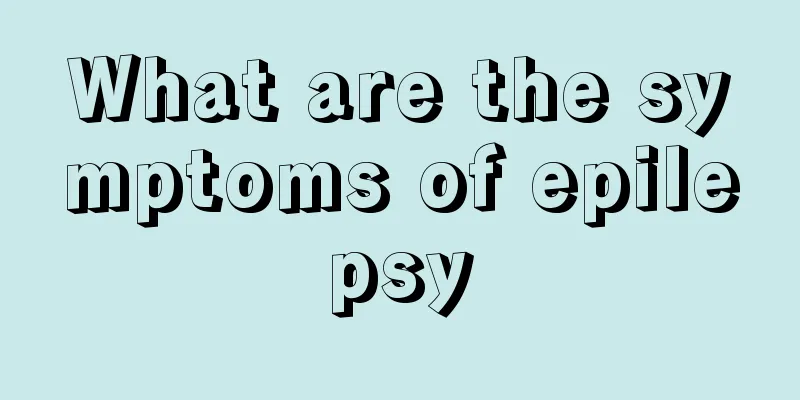What are the symptoms of epilepsy

|
The occurrence of epilepsy will have an impact on the patient's entire life. It often manifests as sudden loss of consciousness, followed by symptoms such as cyanosis of the face, urinary incontinence, foaming at the mouth, and dilated pupils. Some may even cause hallucinations, delusions, and self-harm and violent behavior. 1. Generalized tonic-clonic seizure (grand mal seizure): Sudden loss of consciousness, followed by tonic and then clonic convulsions, often accompanied by screaming, cyanosis, urinary incontinence, tongue biting, foaming at the mouth or blood, dilated pupils, which last for tens of seconds or minutes before the convulsion stops naturally and the patient enters a coma. After waking up, the patient has a short period of dizziness, irritability, and fatigue, and cannot recall the process of the seizure. If the seizure continues and the patient remains in a coma, it is called a grand mal seizure, which is often life-threatening. 2. Absence seizure (petit mal): sudden interruption of mental activity, loss of consciousness, may be accompanied by myoclonus or automatism, each seizure lasts from a few seconds to more than ten seconds, and the EEG shows a complex of slow spikes or slow waves 3 times per second. 3. Simple partial seizure: rigidity, clonic seizure, or paresthesia in a certain part or one side of the limbs, which lasts for a short time and the patient is conscious. If the seizure extends along the motor area to other limbs or the whole body, it may be accompanied by loss of consciousness, which is called Jackson seizure (Jack). After the seizure, the affected limb may be temporarily paralyzed, which is called Todd palsy. 4. Complex partial seizures (psychomotor seizures): Psychosomatic, psychomotor and mixed seizures, often with varying degrees of impaired consciousness and obvious thinking, perception, emotion and psychomotor disorders, may have automatisms such as fugue and sleepwalking, and sometimes violent behaviors such as hurting others and self-harm may occur under the control of hallucinations and delusions. 5. Autonomic nervous system seizures (diencephalic): may be headache type, abdominal pain type, limb pain type, syncope type or cardiovascular type, 6. Primary epilepsy refers to epilepsy without a clear cause, while secondary epilepsy refers to epilepsy caused by intracranial tumors, trauma, infection, parasitic diseases, cerebrovascular diseases, systemic metabolic diseases, etc. 7. Localized seizures are generally seen in patients with organic damage to the cerebral cortex, manifested as paroxysmal twitching or paresthesias at the corner of the mouth, fingers or toes on one side, which may spread to one side of the body. When the seizure affects both sides of the body, it may manifest as a grand mal seizure. 8. Complex partial seizures are accompanied by impaired consciousness and inability to recall the course of the seizure. They may also manifest as staring and automatisms such as smacking lips, chewing, groping, wandering, fiddling, humming, mumbling or other symptoms and signs. |
<<: What are the contraindications for arsenic poisoning?
>>: What to do if the cesarean section scar becomes hard
Recommend
How long can you live with advanced lung cancer? What are the treatment methods for advanced lung cancer?
Lung cancer is a very scary disease. It sounds sc...
What is the best way to treat mild anal fistula
Anal fistula is a very common anorectal disease. ...
The difference between removable dentures and porcelain teeth
In our daily life, tooth bleeding is the most com...
There are many small black spots on the face_What are the small black spots on the face
When the sunlight is strong, people are advised t...
Is tongue cancer grade 1 serious?
The incidence of tongue cancer is also very high....
Explain in detail the common treatment methods of lung cancer
Lung cancer has become a highly prevalent oncolog...
What should I do if I am allergic to hair dye?
Hair dyeing is a hairdressing technique. Loving b...
Can I have children after liver cancer surgery?
Some patients with liver cancer who come to see a...
How to clean the dirt in the oven?
Nowadays, many families have ovens, and they usua...
How about laser spot removal
Most women start to have spots on their faces aft...
Why is there double vision during radiotherapy and chemotherapy for nasopharyngeal carcinoma? How to treat it
After suffering from nasopharyngeal carcinoma, ra...
How to wash black ink on clothes
In life, many students or people get ink splashed...
Psychological care for elderly patients with osteosarcoma
Today's clinical nursing pays special attenti...
What does a mole on the foot mean?
Moles are very common in the human body. Basicall...
What to do if the baby's neck is submerged
The baby's skin is particularly delicate. If ...









